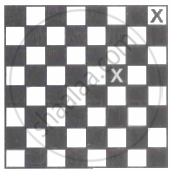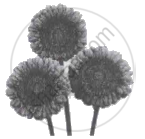Advertisements
Advertisements
Question
An insurance company insured 3000 scooters, 4000 cars and 5000 trucks. The probabilities of the accident involving a scooter, a car and a truck are 0.02, 0.03 and 0.04 respectively. One of the insured vehicles meet with an accident. Find the probability that it is a (i) scooter (ii) car (iii) truck.
Solution
Let E1, E2 and E3 denote the events that the vehicle is a scooter, a car and a truck, respectively.
Let A be the event that the vehicle meets with an accident.
It is given that there are 3000 scooters, 4000 cars and 5000 trucks.
Total number of vehicles = 3000 + 4000 + 5000 = 12000
P(E1) = \[\frac{3000}{12000} = \frac{1}{4}\]
P(E2) = \[\frac{4000}{12000} = \frac{1}{3}\]
P(E3) = \[\frac{5000}{12000} = \frac{5}{12}\]
The probability that the vehicle, which meets with an accident, is a scooter is given by P (E1/A).
\[P\left( A/ E_1 \right) = 0 . 02 = \frac{2}{100}\]
\[P\left( A/ E_2 \right) = 0 . 03 = \frac{3}{100}\]
\[P\left( A/ E_3 \right) = 0 . 04 = \frac{4}{100}\]
\[\text{ Using Bayes' theorem, we get} \]
\[\left( i \right) \text{ Required probability } = P\left( E_1 /A \right) = \frac{P\left( E_1 \right)P\left( A/ E_1 \right)}{P\left( E_1 \right)P\left( A/ E_1 \right) + P\left( E_2 \right)P\left( A/ E_2 \right) + + P\left( E_2 \right)P\left( A/ E_2 \right)}\]
\[ = \frac{\frac{1}{4} \times \frac{2}{100}}{\frac{1}{4} \times \frac{2}{100} + \frac{1}{3} \times \frac{3}{100} + \frac{5}{12} \times \frac{4}{100}}\]
\[ = \frac{\frac{1}{2}}{\frac{1}{2} + 1 + \frac{5}{3}} = \frac{\frac{1}{2}}{\frac{3 + 6 + 10}{6}} = \frac{3}{19}\]
\[\left( ii \right) \text{ Required probability } = P\left( E_2 /A \right) = \frac{P\left( E_2 \right)P\left( A/ E_2 \right)}{P\left( E_1 \right)P\left( A/ E_1 \right) + P\left( E_2 \right)P\left( A/ E_2 \right) + + P\left( E_2 \right)P\left( A/ E_2 \right)}\]
\[ = \frac{\frac{1}{3} \times \frac{3}{100}}{\frac{1}{4} \times \frac{2}{100} + \frac{1}{3} \times \frac{3}{100} + \frac{5}{12} \times \frac{4}{100}}\]
\[ = \frac{1}{\frac{1}{2} + 1 + \frac{5}{3}} = \frac{1}{\frac{3 + 6 + 10}{6}} = \frac{6}{19}\]
\[\left( iii \right) \text{ Required probability } = P\left( E_2 /A \right) = \frac{P\left( E_3 \right)P\left( A/ E_3 \right)}{P\left( E_1 \right)P\left( A/ E_1 \right) + P\left( E_2 \right)P\left( A/ E_2 \right) + + P\left( E_2 \right)P\left( A/ E_2 \right)}\]
\[ = \frac{\frac{5}{12} \times \frac{4}{100}}{\frac{1}{4} \times \frac{2}{100} + \frac{1}{3} \times \frac{3}{100} + \frac{5}{12} \times \frac{4}{100}}\]
\[ = \frac{\frac{5}{3}}{\frac{1}{2} + 1 + \frac{5}{3}} = \frac{\frac{5}{3}}{\frac{3 + 6 + 10}{6}} = \frac{10}{19}\]
APPEARS IN
RELATED QUESTIONS
In answering a question on a multiple choice test, a student either knows the answer or guesses. Let 3/4 be the probability that he knows the answer and 1/4 be the probability that he guesses. Assuming that a student who guesses at the answer will be correct with probability 1/4 What is the probability that the student knows the answer given that he answered it correctly?
A laboratory blood test is 99% effective in detecting a certain disease when it is in fact, present. However, the test also yields a false positive result for 0.5% of the healthy person tested (that is, if a healthy person is tested, then, with probability 0.005, the test will imply he has the disease). If 0.1 percent of the population actually has the disease, what is the probability that a person has the disease given that his test result is positive?
Two groups are competing for the position on the board of directors of a corporation. The probabilities that the first and the second groups will win are 0.6 and 0.4 respectively. Further, if the first group wins, the probability of introducing a new product is 0.7 and the corresponding probability is 0.3 if the second group wins. Find the probability that the new product introduced was by the second group.
Probability that A speaks truth is `4/5` . A coin is tossed. A reports that a head appears. The probability that actually there was head is ______.
Three machines E1, E2 and E3 in a certain factory producing electric bulbs, produce 50%, 25% and 25% respectively, of the total daily output of electric bulbs. It is known that 4% of the bulbs produced by each of machines E1 and E2are defective and that 5% of those produced by machine E3 are defective. If one bulb is picked up at random from a day's production, calculate the probability that it is defective.
An insurance company insured 2000 scooter drivers, 4000 car drivers and 6000 truck drivers. The probabilities of an accident for them are 0.01, 0.03 and 0.15, respectively. One of the insured persons meets with an accident. What is the probability that he is a scooter driver or a car driver?
Suppose a girl throws a die. If she gets 1 or 2, she tosses a coin three times and notes the number of tails. If she gets 3, 4, 5 or 6, she tosses a coin once and notes whether a 'head' or 'tail' is obtained. If she obtained exactly one 'tail', then what is the probability that she threw 3, 4, 5 or 6 with the die?
Suppose 5 men out of 100 and 25 women out of 1000 are good orators. An orator is chosen at random. Find the probability that a male person is selected. Assume that there are equal number of men and women.
In a class, 5% of the boys and 10% of the girls have an IQ of more than 150. In this class, 60% of the students are boys. If a student is selected at random and found to have an IQof more than 150, find the probability that the student is a boy.
Suppose we have four boxes A, B, C, D containing coloured marbles as given below:
Figure
One of the boxes has been selected at random and a single marble is drawn from it. If the marble is red, what is the probability that it was drawn from box A? box B? box C?
An insurance company insured 2000 scooters and 3000 motorcycles. The probability of an accident involving a scooter is 0.01 and that of a motorcycle is 0.02. An insured vehicle met with an accident. Find the probability that the accidented vehicle was a motorcycle.
There are three coins. One is two-headed coin (having head on both faces), another is biased coin that comes up heads 75% of the times and third is also a biased coin that comes up tail 40% of the times. One of the three coins is chosen at random and tossed, and it shows heads. What is the probability that it was the two-headed coin?
In a factory, machine A produces 30% of the total output, machine B produces 25% and the machine C produces the remaining output. If defective items produced by machines A, B and C are 1%, 1.2%, 2% respectively. Three machines working together produce 10000 items in a day. An item is drawn at random from a day's output and found to be defective. Find the probability that it was produced by machine B?
A company has two plants to manufacture bicycles. The first plant manufactures 60% of the bicycles and the second plant 40%. Out of the 80% of the bicycles are rated of standard quality at the first plant and 90% of standard quality at the second plant. A bicycle is picked up at random and found to be standard quality. Find the probability that it comes from the second plant.
Three urns A, B and C contain 6 red and 4 white; 2 red and 6 white; and 1 red and 5 white balls respectively. An urn is chosen at random and a ball is drawn. If the ball drawn is found to be red, find the probability that the ball was drawn from urn A.
There are three coins. One is two headed coin, another is a biased coin that comes up heads 75% of the time and third is an unbiased coin. One of the three coins is chosen at random and tossed, it shows heads, what is the probability that it was the two headed coin?
Let d1, d2, d3 be three mutually exclusive diseases. Let S be the set of observable symptoms of these diseases. A doctor has the following information from a random sample of 5000 patients: 1800 had disease d1, 2100 has disease d2 and the others had disease d3. 1500 patients with disease d1, 1200 patients with disease d2 and 900 patients with disease d3 showed the symptom. Which of the diseases is the patient most likely to have?
A test for detection of a particular disease is not fool proof. The test will correctly detect the disease 90% of the time, but will incorrectly detect the disease 1% of the time. For a large population of which an estimated 0.2% have the disease, a person is selected at random, given the test, and told that he has the disease. What are the chances that the person actually have the disease?
A is known to speak truth 3 times out of 5 times. He throws a die and reports that it is one. Find the probability that it is actually one.
If E1 and E2 are equally likely, mutually exclusive and exhaustive events and `"P"("A"/"E"_1 )` = 0.2, `"P"("A"/"E"_2)` = 0.3. Find `"P"("E"_1/"A")`
A box contains three coins: two fair coins and one fake two-headed coin is picked randomly from the box and tossed. If happens to be head, what is the probability that it is the two-headed coin?
There are three social media groups on a mobile: Group I, Group II and Group III. The probabilities that Group I, Group II and Group III sending the messages on sports are `2/5, 1/2`, and `2/3` respectively. The probability of opening the messages by Group I, Group II and Group III are `1/2, 1/4` and `1/4` respectively. Randomly one of the messages is opened and found a message on sports. What is the probability that the message was from Group III
Solve the following:
Given three identical boxes, I, II, and III, each containing two coins. In box I, both coins are gold coins, in box II, both are silver coins and in box III, there is one gold and one silver coin. A person chooses a box at random and takes out a coin. If the coin is of gold, what is the probability that the other coin in the box is also of gold?
The odds in favour of drawing a king from a pack of 52 playing cards is ______.
Suppose you have two coins which appear identical in your pocket. You know that one is fair and one is 2-headed. If you take one out, toss it and get a head, what is the probability that it was a fair coin?
Refer to Question 41 above. If a white ball is selected, what is the probability that it came from Bag 2
A shopkeeper sells three types of flower seeds A1, A2 and A3. They are sold as a mixture where the proportions are 4:4:2 respectively. The germination rates of the three types of seeds are 45%, 60% and 35%. Calculate the probability that it is of the type A2 given that a randomly chosen seed does not germinate.
An item is manufactured by three machines A, B and C. Out of the total number of items manufactured during a specified period, 50% are manufactured on A, 30% on B and 20% on C. 2% of the items produced on A and 2% of items produced on B are defective, and 3% of these produced on C are defective. All the items are stored at one godown. One item is drawn at random and is found to be defective. What is the probability that it was manufactured on machine A?
In a bolt factory, machines X, Y and Z manufacture 20%, 35% and 45% respectively of the total output. Of their output 8%, 6% and 5% respectively are defective bolts. One bolt is drawn at random from the product and is found to be defective. What is the probability that it was manufactured in machine Y?
| CASE-BASED/DATA-BASED |
 |
| An insurance company believes that people can be divided into two classes: those who are accident prone and those who are not. The company’s statistics show that an accident-prone person will have an accident at some time within a fixed one-year period with a probability 0.6, whereas this probability is 0.2 for a person who is not accident prone. The company knows that 20 percent of the population is accident prone. |
Based on the given information, answer the following questions.
- What is the probability that a new policyholder will have an accident within a year of purchasing a policy?
- Suppose that a new policyholder has an accident within a year of purchasing a policy. What is the probability that he or she is accident prone?
Three persons A, B and C apply for a job a manager in a private company. Chances of their selection are in the ratio 1:2:4. The probability that A, B and C can introduce chances to increase the profits of a company are 0.8, 0.5 and 0.3 respectively. If increase in the profit does not take place, find the probability that it is due to the appointment of A.
Read the following passage and answer the questions given below.
|
A shopkeeper sells three types of flower seeds A1, A2, A3. They are sold is the form of a mixture, where the proportions of these seeds are 4:4:2 respectively. The germination rates of the three types of seeds are 45%, 60% and 35% respectively.
|
Based on the above information:
- Calculate the probability that a randomly chosen seed will germinate.
- Calculate the probability that the seed is of type A2, given that a randomly chosen seed germinates.
The Probability that A speaks truth is `3/4` and that of B is `4/5`. The probability that they contradict each other in stating the same fact is p, then the value of 40p is ______.
Let P denotes the probability of selecting one white and one black square from the chessboard so that they are not in the same row and also not in the same column (an example of this kind of the choice is shown in figure), then (1024)P is ______.

In an entrance test, there are multiple choice questions. There are four possible answers to each question, of which one is correct. The probability that a student knows the answer to a question is 90%. If he gets the correct answer to a question, then the probability that he was guessing is ______.
A jewellery seller has precious gems in white and red colour which he has put in three boxes.
The distribution of these gems is shown in the table given below:
| Box | Number of Gems | |
| White | Red | |
| I | 1 | 2 |
| I | 2 | 3 |
| III | 3 | 1 |
He wants to gift two gems to his mother. So, he asks her to select one box at random and pick out any two gems one after the other without replacement from the selected box. The mother selects one white and one red gem.
Calculate the probability that the gems drawn are from Box II.

